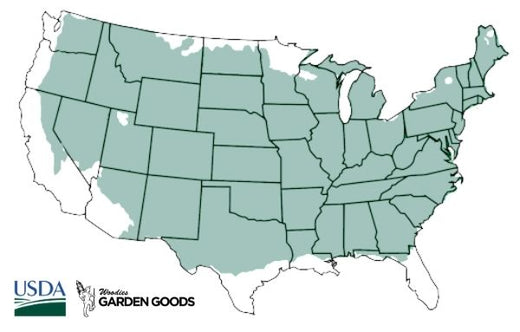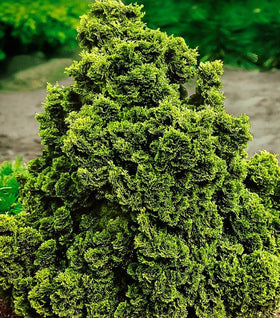Templehof Hinoki Cypress are one of the easiest to grow and one of the most underused ornamental plants available today. In order for Templehof Hinoki Cypress to give their maximum performance, certain fertilization requirements must be met. Despite their medium growth patterns, Templehof Hinoki Cypress are considered to be light feeders. Although many well established Templehof Hinoki Cypress perform wonderfully in the garden without being fertilized, they will do even better with a regular fertilization program.
Apply an early spring fertilizer with a product such as Espoma Tree-tone or Plant-tone at the recommended rate this will give the plant a boost of nitrogen that will be needed for healthy abundant foliage. Follow this up with a early summer application of Espoma Holly-Tone, this will provide the necessary nutrients and raise the acid level in the soil which conifers favor. Espoma products are easy to use, just sprinkle around the base of the plant and water it in. Be careful with products such as miracle-grow as these products can burn newly planted plants when not used at the recommended rates. Slow-release fertilizer can help prevent rapid sucker growth that is vulnerable to diseases and insects.
In choosing the basic type of fertilizer for your Templehof Hinoki Cypress needs, it is important to determine what you need your juniper to do. If your plants are well established, and you are not concerned about more growth, choose a fertilizer that has a smaller first number, and a larger second and third number. For example, a 4-8-8 fertilizer with minor elements included would be a good choice for a well established juniper. If your cypress are younger plants, and you want them to concentrate their energies on growing for a few years, you may wish to choose a fertilizer that has a higher first number such as 12-4-8 or 10-10-10. Be sure that these fertilizers have minor elements as well. No matter what fertilizer you choose, “Always Read the Label”. Do not apply more fertilizer than is recommended on the label. Organic fertilizers such as Dehydrated Cow Manure or Milorganite may provide an excellent source of slow release nutrients in addition to your primary fertilizer.
In the southeastern United States, three fertilizer applications per year are usually adequate to supply your Templehof Hinoki Cypresss nutritional needs. Generally, an application sometime during the first part of March, followed by a second application during the first part of May, and a final third application during the first part of July should be sufficient for you Templehof Hinoki Cypress fertilization needs. Always consult your Extension Service and your local nursery experts as to specific recommendations of fertilizers for your area. If you do not have acid soil, soil tests may be necessary followed by ph adjustments. Templehof Hinoki Cypress plants generally do well in acidic soils with ph readings from 5.5 to 6.8. If the ph of your soil is not correct, it may affect the ability of your cypress to absorb the fertilizer that is applied. It would not be a bad idea to have a soil sample checked with your local Extension Service before applying fertilizer.
When you have selected your fertilizer and are ready to apply it, be sure to rake your mulch back to the drip line of each plant. Apply the fertilizer according to the label directions immediately on top of the soil, and be sure to water the plant thoroughly after the application. You can then rake the mulch back around the base of the Templehof Hinoki Cypress. Although it is tempting to spend less time by not raking the mulch back during fertilization, the results will be less than desirable, if the fertilizer is applied on top of the mulch.
Proper fertilization of your Templehof Hinoki Cypress will lead to healthier and more disease resistant plants, as well as provide you with many more enjoyable blooms. Always, read the label on your fertilizer bag, and follow the instructions.
A short Course on Fertilizers:
When looking at most fertilizers, they are described by three numbers on the bag. An example would be 10-10-10 or 12-4-8. The first of these three numbers refers to Nitrogen, which is the primary element necessary for good, balanced growth within the plant. Plants that are deficient in Nitrogen are usually not growing vigorously, and sometimes exhibit pale colored foliage. Not all Nitrogen deficiencies result in stunted growth. Sometimes, the growth is taller and longer with less than desirable branching when Nitrogen is deficient. The second number in the fertilizer equation is representative of Phosphorus. A deficiency of Phosphorus may affect the energy transfer in the plant, and result in stunted growth as well. Also, plants with insufficient amounts of Phosphorus may have poorer root systems. Potassium is the element represented by the third number on the fertilizer bag. Plants that are deficient in Potassium, are usually growing more slowly than normal, have fewer flowers and seed, and are more susceptible to disease than plants with adequate levels of Potassium. Although the three elements just mentioned are the major elements necessary for good plant performance, there some minor elements that are just as important in consideration of plant nutrition.
Minor elements that are not included in the three numbers listing on the front of fertilizer bags are very important considerations when choosing your plants fertilizer. Elements such as Magnesium, Sulfur, Calcium, Iron, Manganese, Copper, Zinc, Boron, and Molybdenum play very important roles in providing plants with adequate nutrition. Many times, less expensive fertilizers are sold that contain only the major elements needed, but not the minor elements. Always be sure to look on the fertilizer label on the back of the bag to see exactly what is included in the fertilizer.
![Tempelhof Hinoki Cypress Hardiness Zone 4-8]()






